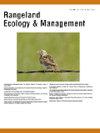基于无人机系统和两步随机森林分类的山地景观花卉资源制图
IF 2.4
3区 环境科学与生态学
Q2 ECOLOGY
引用次数: 0
摘要
监测植物的生物多样性是了解陆地生态系统的关键一步。然而,人工量化开花植被的方法在时间和人力上都是昂贵的。在大型景观中,这些有限的方法可能无法捕捉到植物资源的时空变化。传感器和无人机(UAV)平台的最新进展为在景观水平上表征植物资源的动态分布提供了机会。在这项研究中,利用无人机图像和多步机器学习分类分析来量化地形、植被和花序大小可变的非农业环境中的花卉资源。在整个研究过程中,共分类了7种开花物种,面积为2 138 m2,占整体景观的0.5%。根据无人机影像分类的花区时间变化,确定重要物种的花期。考虑到无人机图像中花朵的极度罕见,模型表现良好。在土地覆盖分类模型中,花类的平均敏感性为0.77,平均特异性为0.99。单个花类也表现良好,大多数花类的敏感性和特异性值都在0.90以上。利用无人机对非农业环境下的花卉资源进行鉴定是一种可行的方法。更强大和全面的无人机和花资源采样计划将有助于分类,更好地表征无人机图像中花资源的变异性。本文章由计算机程序翻译,如有差异,请以英文原文为准。
Mapping Floral Resources in Montane Landscapes Using Unmanned Aerial Systems and Two-step Random Forest Classifications
Monitoring floral biodiversity is a critical step in understanding terrestrial ecosystems. However, manual methods to quantify flowering vegetation are costly in time and personnel. In large landscapes, these limited methods may not capture the spatial and temporal variation of floral resources. Recent advances in sensors and unmanned aerial vehicle (UAV) platforms offer opportunities to characterize the dynamic distribution of floral resources at the landscape level. In this study, UAV imagery and a multistep machine learning classification analysis were used to quantify floral resources in nonagricultural environments, where topography, vegetation, and inflorescence size were variable. Seven flowering species covering an area of 2 138 m2 were classified throughout our study, equaling 0.5% of the overall landscape. We determined the period of flowering for important species based on the temporal changes of the floral area classified from UAV images. Models performed well considering the extreme rarity of flowers in the UAV images. The flower class in the land cover classification models performed well with an average sensitivity of 0.77 and average specificity of 0.99. Individual flower classes also performed well with the majority of flower classes receiving sensitivity and specificity values of over 0.90. The use of UAVs is a feasible method for characterizing floral resources in nonagricultural settings. Classifications would benefit from a more robust and comprehensive UAV and floral resource sampling plan, to better characterize the variability of floral resources in UAV imagery.
求助全文
通过发布文献求助,成功后即可免费获取论文全文。
去求助
来源期刊

Rangeland Ecology & Management
农林科学-环境科学
CiteScore
4.60
自引率
13.00%
发文量
87
审稿时长
12-24 weeks
期刊介绍:
Rangeland Ecology & Management publishes all topics-including ecology, management, socioeconomic and policy-pertaining to global rangelands. The journal''s mission is to inform academics, ecosystem managers and policy makers of science-based information to promote sound rangeland stewardship. Author submissions are published in five manuscript categories: original research papers, high-profile forum topics, concept syntheses, as well as research and technical notes.
Rangelands represent approximately 50% of the Earth''s land area and provision multiple ecosystem services for large human populations. This expansive and diverse land area functions as coupled human-ecological systems. Knowledge of both social and biophysical system components and their interactions represent the foundation for informed rangeland stewardship. Rangeland Ecology & Management uniquely integrates information from multiple system components to address current and pending challenges confronting global rangelands.
 求助内容:
求助内容: 应助结果提醒方式:
应助结果提醒方式:


